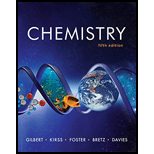
Chemistry: The Science in Context (Fifth Edition)
5th Edition
ISBN: 9780393614046
Author: Thomas R. Gilbert, Rein V. Kirss, Natalie Foster, Stacey Lowery Bretz, Geoffrey Davies
Publisher: W. W. Norton & Company
expand_more
expand_more
format_list_bulleted
Question
Chapter 19, Problem 19.30QP
Interpretation Introduction
Interpretation: The mode of radioactive decay for the isotope of nitrogen with given number of neutrons is to be identified.
Concept introduction: The nuclide that lies above the green belt in the graph of belt of stability, are nuclear rich and those that lie below the green region is nuclear poor. Green nuclide represents stable nuclides and orange nuclide represents unstable nuclide.
The isotopes that are nuclear rich undergo beta emission.
The isotopes that are nuclear poor undergo positron emission or electron capture.
To determine: The mode of radioactive decay for the isotope of nitrogen with eleven neutrons.
Expert Solution & Answer
Want to see the full answer?
Check out a sample textbook solution
Students have asked these similar questions
Don't use ai to answer I will report you answer
Consider a solution of 0.00304 moles of 4-nitrobenzoic acid (pKa = 3.442) dissolved in 25 mL water and titrated with 0.0991 M NaOH. Calculate the pH at the equivalence point
What is the name of the following compound?
SiMe3
Chapter 19 Solutions
Chemistry: The Science in Context (Fifth Edition)
Ch. 19.2 - Prob. 1PECh. 19.3 - Prob. 2PECh. 19.4 - Prob. 3PECh. 19.5 - Prob. 4PECh. 19.6 - Prob. 5PECh. 19.9 - Prob. 6PECh. 19 - Prob. 19.1VPCh. 19 - Prob. 19.2VPCh. 19 - Prob. 19.3VPCh. 19 - Prob. 19.4VP
Ch. 19 - Prob. 19.5VPCh. 19 - Prob. 19.6VPCh. 19 - Prob. 19.7VPCh. 19 - Prob. 19.8VPCh. 19 - Prob. 19.9VPCh. 19 - Prob. 19.10VPCh. 19 - Prob. 19.11QPCh. 19 - Prob. 19.12QPCh. 19 - Prob. 19.13QPCh. 19 - Prob. 19.14QPCh. 19 - Prob. 19.15QPCh. 19 - Prob. 19.16QPCh. 19 - Prob. 19.17QPCh. 19 - Prob. 19.18QPCh. 19 - Prob. 19.19QPCh. 19 - Prob. 19.20QPCh. 19 - Prob. 19.21QPCh. 19 - Prob. 19.22QPCh. 19 - Prob. 19.23QPCh. 19 - Prob. 19.24QPCh. 19 - Prob. 19.25QPCh. 19 - Prob. 19.26QPCh. 19 - Prob. 19.27QPCh. 19 - Prob. 19.28QPCh. 19 - Prob. 19.29QPCh. 19 - Prob. 19.30QPCh. 19 - Prob. 19.31QPCh. 19 - Prob. 19.32QPCh. 19 - Prob. 19.33QPCh. 19 - Prob. 19.34QPCh. 19 - Prob. 19.35QPCh. 19 - Prob. 19.36QPCh. 19 - Prob. 19.37QPCh. 19 - Prob. 19.38QPCh. 19 - Prob. 19.39QPCh. 19 - Prob. 19.40QPCh. 19 - Prob. 19.41QPCh. 19 - Prob. 19.42QPCh. 19 - Prob. 19.43QPCh. 19 - Prob. 19.44QPCh. 19 - Prob. 19.45QPCh. 19 - Prob. 19.46QPCh. 19 - Prob. 19.47QPCh. 19 - Prob. 19.48QPCh. 19 - Prob. 19.49QPCh. 19 - Prob. 19.50QPCh. 19 - Prob. 19.51QPCh. 19 - Prob. 19.52QPCh. 19 - Prob. 19.53QPCh. 19 - Prob. 19.54QPCh. 19 - Prob. 19.55QPCh. 19 - Prob. 19.56QPCh. 19 - Prob. 19.57QPCh. 19 - Prob. 19.58QPCh. 19 - Prob. 19.59QPCh. 19 - Prob. 19.60QPCh. 19 - Prob. 19.61QPCh. 19 - Prob. 19.62QPCh. 19 - Prob. 19.63QPCh. 19 - Prob. 19.64QPCh. 19 - Prob. 19.65QPCh. 19 - Prob. 19.66QPCh. 19 - Prob. 19.67QPCh. 19 - Prob. 19.68QPCh. 19 - Prob. 19.69QPCh. 19 - Prob. 19.70QPCh. 19 - Prob. 19.71QPCh. 19 - Prob. 19.72QPCh. 19 - Prob. 19.73QPCh. 19 - Prob. 19.74QPCh. 19 - Prob. 19.75QPCh. 19 - Prob. 19.76QPCh. 19 - Prob. 19.77QPCh. 19 - Prob. 19.78QPCh. 19 - Prob. 19.79QPCh. 19 - Prob. 19.80QPCh. 19 - Prob. 19.81QPCh. 19 - Prob. 19.82QPCh. 19 - Prob. 19.83QPCh. 19 - Prob. 19.84QPCh. 19 - Prob. 19.85APCh. 19 - Prob. 19.86APCh. 19 - Prob. 19.87APCh. 19 - Prob. 19.88APCh. 19 - Prob. 19.89APCh. 19 - Prob. 19.90APCh. 19 - Prob. 19.91APCh. 19 - Prob. 19.92APCh. 19 - Prob. 19.93APCh. 19 - Prob. 19.94APCh. 19 - Prob. 19.95APCh. 19 - Prob. 19.96APCh. 19 - Prob. 19.97APCh. 19 - Prob. 19.98APCh. 19 - Prob. 19.99APCh. 19 - Prob. 19.100AP
Knowledge Booster
Similar questions
- K Draw the starting structure that would lead to the major product shown under the provided conditions. Drawing 1. NaNH2 2. PhCH2Br 4 57°F Sunny Q Searcharrow_forward7 Draw the starting alkyl bromide that would produce this alkyne under these conditions. F Drawing 1. NaNH2, A 2. H3O+ £ 4 Temps to rise Tomorrow Q Search H2arrow_forward7 Comment on the general features of the predicted (extremely simplified) ¹H- NMR spectrum of lycopene that is provided below. 00 6 57 PPM 3 2 1 0arrow_forward
arrow_back_ios
SEE MORE QUESTIONS
arrow_forward_ios
Recommended textbooks for you
 ChemistryChemistryISBN:9781305957404Author:Steven S. Zumdahl, Susan A. Zumdahl, Donald J. DeCostePublisher:Cengage Learning
ChemistryChemistryISBN:9781305957404Author:Steven S. Zumdahl, Susan A. Zumdahl, Donald J. DeCostePublisher:Cengage Learning ChemistryChemistryISBN:9781259911156Author:Raymond Chang Dr., Jason Overby ProfessorPublisher:McGraw-Hill Education
ChemistryChemistryISBN:9781259911156Author:Raymond Chang Dr., Jason Overby ProfessorPublisher:McGraw-Hill Education Principles of Instrumental AnalysisChemistryISBN:9781305577213Author:Douglas A. Skoog, F. James Holler, Stanley R. CrouchPublisher:Cengage Learning
Principles of Instrumental AnalysisChemistryISBN:9781305577213Author:Douglas A. Skoog, F. James Holler, Stanley R. CrouchPublisher:Cengage Learning Organic ChemistryChemistryISBN:9780078021558Author:Janice Gorzynski Smith Dr.Publisher:McGraw-Hill Education
Organic ChemistryChemistryISBN:9780078021558Author:Janice Gorzynski Smith Dr.Publisher:McGraw-Hill Education Chemistry: Principles and ReactionsChemistryISBN:9781305079373Author:William L. Masterton, Cecile N. HurleyPublisher:Cengage Learning
Chemistry: Principles and ReactionsChemistryISBN:9781305079373Author:William L. Masterton, Cecile N. HurleyPublisher:Cengage Learning Elementary Principles of Chemical Processes, Bind...ChemistryISBN:9781118431221Author:Richard M. Felder, Ronald W. Rousseau, Lisa G. BullardPublisher:WILEY
Elementary Principles of Chemical Processes, Bind...ChemistryISBN:9781118431221Author:Richard M. Felder, Ronald W. Rousseau, Lisa G. BullardPublisher:WILEY

Chemistry
Chemistry
ISBN:9781305957404
Author:Steven S. Zumdahl, Susan A. Zumdahl, Donald J. DeCoste
Publisher:Cengage Learning

Chemistry
Chemistry
ISBN:9781259911156
Author:Raymond Chang Dr., Jason Overby Professor
Publisher:McGraw-Hill Education

Principles of Instrumental Analysis
Chemistry
ISBN:9781305577213
Author:Douglas A. Skoog, F. James Holler, Stanley R. Crouch
Publisher:Cengage Learning

Organic Chemistry
Chemistry
ISBN:9780078021558
Author:Janice Gorzynski Smith Dr.
Publisher:McGraw-Hill Education

Chemistry: Principles and Reactions
Chemistry
ISBN:9781305079373
Author:William L. Masterton, Cecile N. Hurley
Publisher:Cengage Learning

Elementary Principles of Chemical Processes, Bind...
Chemistry
ISBN:9781118431221
Author:Richard M. Felder, Ronald W. Rousseau, Lisa G. Bullard
Publisher:WILEY